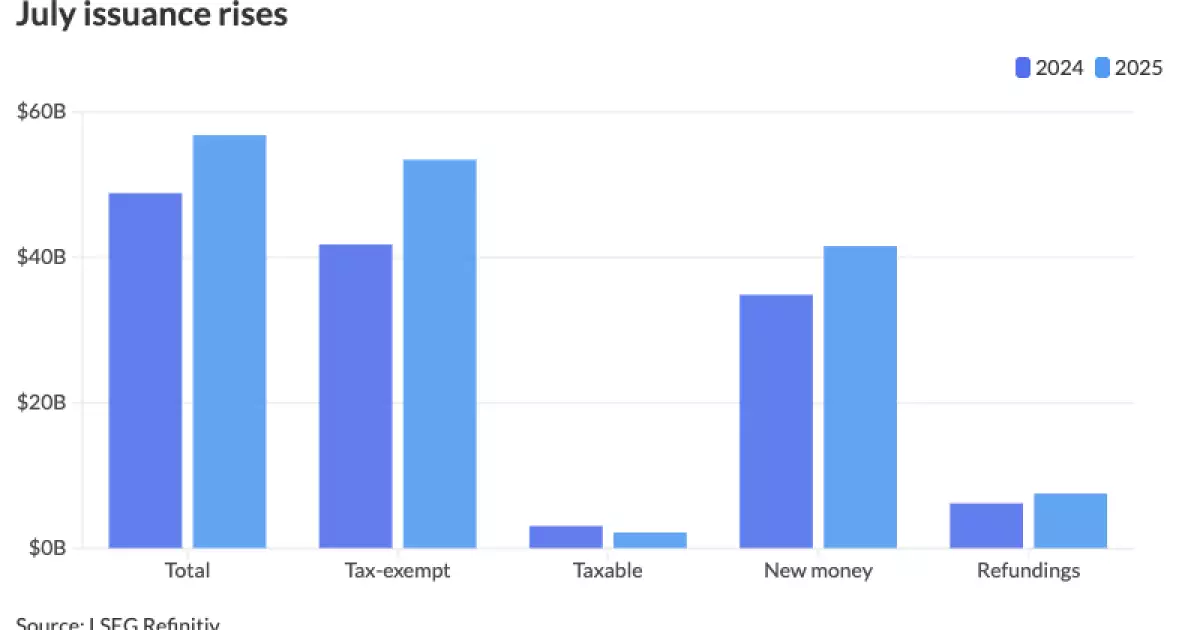Over the first half of the year, the municipal bond market has experienced an unprecedented flood of issuance, shattering recent records and raising serious concerns about sustainability. More than $280 billion has been issued in this period—a 14.3% leap compared to the previous year—testament to issuers’ relentless desire to secure capital amid uncertainties. This aggressive frontloading of debt reveals an underlying vulnerability: a market driven more by strategic reaction than organic needs. While the surge might seem like a robust vote of confidence, it blatantly masks the potential for overheating, which could require a painful correction down the line.
The escalation in issuance isn’t random; it’s a calculated response to anticipated regulatory and fiscal threats. Facing speculations about the possible elimination, or at least downsizing, of tax exemptions—particularly private-activity bonds and cuts for sensitive sectors like healthcare and education—issuers have rushed to lock in funding sources. This preemptive behavior indicates that market participants are acutely aware of policy risks, and instead of hedging, they’re rushing headlong into the market, increasing systemic stress and heightening the risk of a sudden liquidity squeeze.
Market Volatility and Overoptimistic Forecasts
The markets this year have been anything but stable, oscillating between extreme volatility and tentative optimism. The relentless issuance, with weekly volumes reaching as high as $20 billion, suggests that issuers are eager to capitalize on fleeting favorable conditions, often glossing over warning signs of deteriorating market health. The key issue is whether this momentum is sustainable. Many analysts have upgraded their forecasts—from $500 billion to almost $600 billion in total issuance—indicating a herd mentality among market forecasters. Such revisions, especially when fueled by surging supply, should serve as red flags rather than comfort.
This kind of panic-driven acceleration raises questions about the true health of the municipal sector. Are these borrowers genuinely creditworthy, or are they simply taking advantage of temporary market euphoria? History warns us that markets built on such aggressive debt accumulation—especially when coupled with heightened volatility—are vulnerable to abrupt downturns. The very fact that some weeks saw a dramatic decrease in issuance due to market volatility underscores the fragility beneath the surface; investors need to consider whether the current climate is a temporary respite or the calm before a storm.
The Political and Policy Landscape: A Double-Edged Sword
The current political environment adds another layer of uncertainty. While fears about the potential removal of tax exemptions have driven much of the year’s issuance, recent legislative developments seem to have dulled that threat. A recent tax and spending bill left exemptions largely intact, at least for now. However, this defers the issue rather than resolves it. Political calculations tend to oscillate, and future administrations could reintroduce risks, particularly targeting private-activity bonds or sectors like airports, hospitals, and universities—institutions that are crucial to local economies but dependent on favorable tax treatment for their viability.
Furthermore, the influx of debt from prestigious universities and local governments amid this climate of uncertainty reveals a paradox. These well-resourced entities are borrowing money strongly—sometimes more aggressively than the broader market—to secure funding before policy shifts could shut down their access to cheap capital. This pattern suggests a broader, collective anxiety that the legislative landscape remains volatile, pushing borrowers to act now versus risk being left stranded later.
Implications for Investors: A Cautionary Outlook
For those invested in municipal bonds—or contemplating entering this market—the current environment is a warning sign. The market’s exuberance is artificially inflating valuations, with record issuance potentially masking hidden risks. As supply continues to skyrocket, the risk of overleveraging and subsequent correction becomes more pronounced. Investors should be wary of complacency: high short-term yields and record issuance volumes do not guarantee long-term safety.
The divergence in forecast revisions by major financial institutions suggests an overwhelming optimism that may be disconnected from realities on the ground. While higher issuance provides short-term liquidity and momentum, it could foreshadow a correction if demand wanes or if interest rates rise further. The stabilization of the market hinges on whether investors remain confident enough to absorb these surges—and whether they are prepared for the inevitable price adjustments that come with an overheated market.
The Road Ahead: An Unsustainable Path?
As the municipal market continues its extraordinary climb, serious questions arise about its sustainability. The current issuance frenzy appears driven by strategic desperation more than economic fundamentals. Policymakers and investors alike should heed the warning signs: an overheated market, increasing volatility, and a political landscape still fraught with uncertainties. Though the moment may seem lucrative, it is likely to be short-lived, and those who do not recognize the underlying fragility risk bearing costly consequences in the future.
The price of complacency in such a climate will be paid in the form of potentially sharp corrections or liquidity crises. Investors must adopt a cautious stance, scrutinizing not just headline numbers but the broader market dynamics that could unravel when confidence wanes. Confidence, after all, is a delicate foundation in a market as hotly contested and politically sensitive as municipal bonds today.

